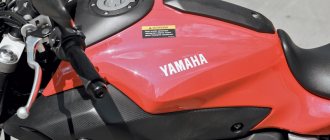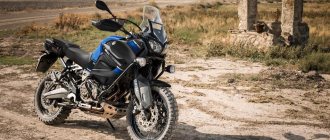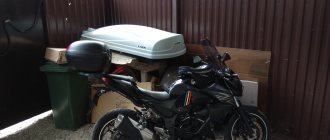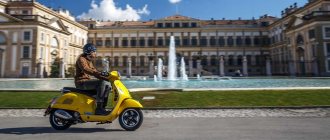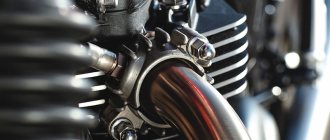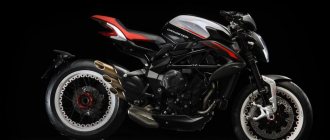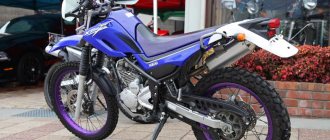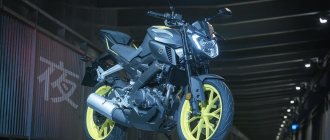| Yamaha Tenéré 700 (2019+) | Yamaha Tenéré 700 Rally Edition (2021+) |
Yamaha Tenéré 700 touring enduro model
was first presented as a concept in 2021, and official sales started in 2021 (2020 model series).
The main target market is Europe. The model will become available in North America closer to 2021. Factory name - Yamaha XTZ690
. The predecessor of the model is the Yamaha XT660Z Tenere.
The model was based on an engine from the MT-07 series - an in-line 2-cylinder liquid-cooled unit with a volume of 689 cm³, producing a claimed 73 hp. power and 68 Nm of torque. The main feature of the engine is the 270° crankshaft, which is why its operation is very reminiscent of V-twins.
The chassis is represented by a steel duplex frame, long-stroke adjustable suspension in the form of an inverted fork at the front and a monoshock absorber at the rear, spoked wheels measuring 21′ and 18′, front 2-piston and rear 1-piston brakes with switchable ABS and a 6-speed gearbox.
Overall, the Yamaha Ténéré 700 is very reminiscent of desert rally racers, and the overall styling is very similar to the Honda CRF1000L Africa Twin, for which the new Ténéré 700 is likely to be a more affordable competitor.
By 2021, Yamaha has offered a new version of the motorcycle on the European market - the Yamaha Ténéré 700 Rally Edition
. It is distinguished by exclusive colors, saddle, LED turn signals, Akrapovič exhaust system and additional equipment in the form of radiator protection, chain, enhanced crankcase protection, grips, etc.
Specifications
Technical characteristics of Yamaha Tenere 700:
| Model | Yamaha Tenere 700 |
| Motorcycle type | touring enduro |
| Year of issue | 2019+ |
| Frame | Steel duplex |
| engine's type | 2-cylinder, 4-stroke, in-line |
| Working volume | 689 cm³ |
| Bore/Stroke | 80.0 x 68.6 mm |
| Compression ratio | 11.5:1 |
| Cooling | liquid |
| Number of valves per cylinder | DOHC, 4 valves per cylinder |
| Fuel supply system | Injector |
| Ignition type | TCI |
| Maximum power | 73.4 hp (54.0 kW) at 9000 rpm |
| Maximum torque | 68.0 Nm (6.9 kg*m) at 6500 rpm |
| Clutch | Multi-disc in oil bath, cable drive |
| Transmission | 6-speed |
| type of drive | chain |
| Front tire size | 90/90 R21 M/C (54V) |
| Rear tire size | 150/70 R18 M/C (70V) |
| Front brakes | 2 discs, 282 mm, 2-piston calipers (ABS) |
| Rear brakes | 1 disc, 245 mm, 1-piston caliper (ABS) |
| Front suspension | 43mm inverted fork (fully adjustable), 210mm travel |
| Rear suspension | Pendulum with monoshock absorber (adjustable preload and rebound), stroke - 200 mm |
| Motorcycle length | 2370 mm |
| Motorcycle width | 905 mm |
| Motorcycle height | 1455 mm |
| Wheelbase | 1595 mm |
| Seat height | 875 mm |
| Minimum ground clearance (clearance) | 240 mm |
| Acceleration 0-100 km/h (0-60 mph) | 4.5 sec[1] |
| Maximum speed | 201 km/h[2] |
| Gas tank capacity | 16.0 l (including reserve - 4.3 l) |
| Motorcycle weight (curb) | 204.0 kg |
Yamaha Tenere
The word Tenere comes from the North African languages - Berber and Tuareg - and means simultaneously “Desert”, “Wildness” and “Loneliness”. Yamaha chose the name after the Sahara Desert region, which spans Niger and Chad and was part of the original Paris-Dakar Rally route. The vast, dry, sandy area was notorious in early rallies for its sandstorms and difficult terrain.
Yamaha Tenere
Yamaha A-S700
Gaiko Alexander, 02/20/2012
Advantages: 1. High rated power, due to which the amplifier firmly “holds” large floor-standing speakers in its hands; 2. There is loudness compensation (LOUDNESS). In addition, the loudness is adjustable, which is a unique property of this amplifier; 3. Natural, even slightly analytical sound throughout the entire frequency range; 4. The feeling that a thing costs more than the money invested in it.
Disadvantages: 1. Some phonograms are slightly hampered by the excessive “honesty” of the presentation of the material; 2. The loudness adjustment does not work as expected and greatly affects the volume. All the same, the desired result is achieved, but not in the usual way.
Comment: In favor of the Yamaha A-S700: 1. The power is sufficient to make it obvious: the amplifier copes well with large speakers: the bass becomes noticeably stronger and acquires more energy. 2. The only amplifier where the loudness depth can be adjusted. This allows you to get comfortable sound at any volume level, but at the same time avoid too harsh “sibilances” 3. Natural, even analytical sound at mid and high frequencies. Cons: 1. Analytical sound sometimes gets in the way. If you listen to obviously low-quality phonograms, then the amplifier conveys all the shortcomings of these phonograms to the listener without any special emotions. In this situation, Denon embellishes the sound a little, and listening becomes more comfortable. And in general, Denon sounds “fatter” and “oilier”. But on good soundtracks this “fatness” is annoying. In this situation, Denon does not reveal all the charm of a good sound source. One day of comparative listening was enough for me to keep the Yamaha. Suddenly the compact cassette deck began to sound good through it. It was not interesting to listen to this deck through Denon. The vinyl player did not impress either in conjunction with the Denon or in conjunction with the Yamaha. I don’t over-compensate. If the recordings are of very high quality, the regulator is set to a slight minus (-1, -1.5). If the recordings are harsh and harsh, I set the regulator to position (-3). If, in addition, there is not enough bass, I put the loudness in the middle position, while at the same time reducing the level of high frequencies with timbre. The bass control is set close to maximum. It looks like the amplifier needs its own speakers to play with. Monitor Audio Silver S8? Through which I listen to him, it seems that the acoustics are not quite his. If Yamaha chooses the right acoustics, then exactly that signature Yamaha sound for which some people love it will appear: strong, collected bass, transparent silvery highs, creating the impression of a sunny frosty day. This is the sound I heard when Yama works with his own acoustics.
My impressions of a 3-hour test drive of the Tenere 700. Exclusively due to the fact that I did not find any reviews about this motorcycle on this site. I don't have much experience in enduro. I ride an NC750X When I saw this bike for the first time, I got the impression that it was a very overpriced bike (it costs 341k UAH in the base, versus 343k UAH for the base 850 goose) But, the opportunity arose to take it for a test drive and I took advantage of the opportunity, for which thanks to the team of the Yamaha dealer in Dnepr. This is a small class of medium-sized adventure games today; this class is most interesting to me now, because... there is a desire to expand tourist routes, but 240-260 kg motorcycles raise some doubts, although I really like Africa automatically.
It has a curb weight of 202 kg, the seating position is comfortable, I rode for almost 3 hours without getting off it, it’s fine to ride in a standing position. The seat is not bad for a stock one, but for traveling it is a bit narrow and hard. The passenger seat is small and not very comfortable, which is probably why at the time of the test a comfortable optional seat was available only for the passenger; for the driver it was not yet on sale.
Minimum vibrations, even when running on stock 80:20 tires. The stock tires are good, Pirelli Rally. The tidy is not bad, but the tachometer is noticeably not very good. The stock exhaust is fire, the crankshaft at 270 degrees makes it behave like a V2, the revs are recorded quite well by ear. The exhaust is good, I constantly revved up the gas to listen to it. The engine is powerful, in second place without clutch the front wheel can lift during acceleration. It’s responsive in gear and gets traction smoothly. The gearbox is not perfect; I personally had to shift downwards with my toe once in a while, and ended up stomping my entire foot. The clutch is a bit heavy. Perhaps by adjusting the gearbox foot and clutch force everything would be cured. Quickshifter option. The pendants are soft, a little “bouncy”. All adjustments, for asphalt from the standard setting I would make the fork stiffer, the grip in turns with the front wheel is not obvious. Worked great on dirt, gravel, curbs and in parks. Stroke 200mm +. I liked the behavior on the asphalt, it’s certainly not an 850 goose, but even on these tires it behaved even better in corners than I expected. The center of gravity is slightly lower than the seat, according to my feelings. The center of gravity is lower on the NC750X, higher on the 850 Goose. The head light is chic, 4 LED lenses. ABS on 2 wheels, with switchable rear, no other safety systems.
The stock tires are good, Pirelli Rally. The tidy is not bad, but the tachometer is noticeably not very good. The stock exhaust is fire, the crankshaft at 270 degrees makes it behave like a V2, the revs are recorded quite well by ear. The exhaust is good, I constantly revved up the gas to listen to it. The engine is powerful, in second place without clutch the front wheel can lift during acceleration. It’s responsive in gear and gets traction smoothly. The gearbox is not perfect; I personally had to shift downwards with my toe once in a while, and ended up stomping my entire foot. The clutch is a bit heavy. Perhaps by adjusting the gearbox foot and clutch force everything would be cured. Quickshifter option. The pendants are soft, a little “bouncy”. All adjustments, for asphalt from the standard setting I would make the fork stiffer, the grip in turns with the front wheel is not obvious. Worked great on dirt, gravel, curbs and in parks. Stroke 200mm +. I liked the behavior on the asphalt, it’s certainly not an 850 goose, but even on these tires it behaved even better in corners than I expected. The center of gravity is slightly lower than the seat, according to my feelings. The center of gravity is lower on the NC750X, higher on the 850 Goose. The head light is chic, 4 LED lenses. ABS on 2 wheels, with switchable rear, no other safety systems.
The lack of traction, given the nature of the engine, the narrow rear wheel and less grip on the asphalt on the checker is a disadvantage for me, but I considered it from the point of view of tourist use. The lowest point under the frame is the rear suspension links; the stock protection does not cover it. The turn signal flag is a little high and narrow, you have to stretch. I liked the brakes, brembo, double ones in front. Braking with the front wheel feels (I haven’t tried emergency braking), about the same loading as on my NC750X, the fork loads quite quickly.
Wind protection up to 80-90 is excellent, then it gradually blows into the helmet. My height is 178 cm, in principle I could easily maintain 100-120 for quite a long time. After 140 I’m no longer comfortable, I have to lie down on the tank. By placing the stock glass higher, I think everything would be resolved; the appropriate frame for adjusting it already exists. I reached the ground without any problems with my entire foot. The range on the tank according to the salon manager is 370-400 km. Consumption 4-5 liters. What I noticed is that the gas tank cap differs in design from others that I have seen on other motorcycles (but I’m not a very experienced motorcyclist), so I’m not sure that this tank has fasteners like a tanklock from Givi, the issue with the tank bag is open.
I liked the mot. Especially because it’s light compared to my Honda and heavy tourneys. The engine makes me happy, the seating position and suspension are comfortable for me. One of the main contenders for the next motorcycle, although it will be interesting to see if the 800-50 cc will make an Africa Twin, because... I like Honda's automatic. The question of cost is open, but less so. In principle, you can get confused and take it in Europe. It’s a pity that the database doesn’t include a quickshifter or traction control.
Sizon.info
Tenere is the driest and most uninhabitable area of the Sahara Desert. Area – 400,000 km2. The average temperature is 42`C in the shade (if you can find it). Any forms of life are absent, since there is no water for many hundreds of kilometers around, and precipitation levels are only 25 mm per year.
It all started in 1976 with the XT 500 model, which quickly gained popularity in Europe. Multi-purpose enduro has become very successful in most European countries. The Paris-Dakar Rally has always been the highest point for dreamers of adventure, of traveling to distant, inaccessible places. Yamaha Motor France took the lead with modified XT 500 rally bikes.
Of course, Yamaha's European division planned to ride this new market trend. They raised eyebrows at Yamaha Japan headquarters in 1981 when they proposed producing replica rally models with a 30-liter fuel tank and a larger single-cylinder or even twin engine. This was a difficult concept to understand in Japan, where dreams of adventure were not yet popular. And no one could imagine that ordinary motorcyclists would want to ride with such large fuel tanks. But the engineers still accepted the challenge and created the first Tenere model in 1983!
Image and functionality The Paris-Dakar Rally was at the peak of its popularity. The Tenere has become a new kind of versatile touring motorcycle, capable of any journey, easy to maintain and at an affordable price. At the same time, it had the image of a large and “adult” bike. The name Tenere was borrowed from the famous African desert, one of the most difficult stages of the rally. This motorcycle soon became one of Yamaha's bestsellers! In the first 10 years that production began, 61,000 Tenere 600/660 units were sold in Europe (including 20,500 in France, the largest single market). 1983 First generation. New category.
The XT600Z Tenere, badged 34L, was first introduced at the Paris Motor Show in October 1982. Its first color scheme became legendary: white with a red block chain, like the Yamaha emblem, and blue with black blocks, which was inspired by the colors of the French Yamaha Motor racing team (Sonauto / Gauloises). The first Tenere brought many innovations to the enduro segment, such as a front disc brake (drum brakes were common at the time), a progressive rear mono shock absorber and an aluminum swingarm with 235 mm of travel. The front fork also had excellent characteristics: diameter 41 mm, pneumatic, stroke 255 mm. The engine (bored version of the XT 550) had a displacement of 595 cc, greater low-end thrust, and a power of 43 hp with a top speed of 160 km/h. The electrical circuit was simple; there was no electric starter. A tiny plastic headlight cover and a huge 30-litre fuel tank completed the look. 1986 Second generation. Electric starter.
At the Paris show in late 1985, the second generation XT600Z Tenere, badged 1VJ, was greeted by an enthusiastic crowd. The new version was even closer to the factory rally bikes, although the fuel tank was reduced to 23 liters. This was partly due to the air filter being moved from under the seat to under the fuel tank. The electric starter has become a contribution to the daily use of the motorcycle. Power was increased to 46 hp thanks to larger valves, changes to the carburetor and a new air filter design. The maximum speed has increased to 163 km/h. 1988 Third generation. Full protection.
The third generation XT600Z, labeled 3AJ, was born after a complete redesign. The surprising differences brought it closer to the rally versions again. The motorcycle got a large dual headlight, which was new in this category. The tank remained the same capacity of 23 liters. There have been some significant changes to the engine, particularly to the cylinder head. The size of the cylinder cooling fins has increased. To improve cooling, the oil circulation system was changed, and the front wing became lower. The rear disc brake has been strengthened. 1991 Fourth generation. New 5-valve 660 cm3 engine
Eight years after the first Tenere, Yamaha engineers followed their traditions and continued to realize the dream with the XTZ 660 Tenere, introducing the latest in engine and frame technology. They used a modern liquid-cooled engine with five valves. At first this seemed to go against the principle of simplicity, but it nevertheless ensured reliability, minimal maintenance, improved the overall friendliness of the model, and provided a healthy 48 hp. The new Tenere is leaner and less rugged than before, following the trend towards more road-ready styling instead of being used, as before, primarily off-road. For example, the suspension travel has become shorter, and the fuel tank capacity has been reduced to 20 liters. 1994 Fifth generation. Cowl.
In 1994, a new generation of the 5-valve XTZ appeared. Its main difference was a completely new plastic fairing with a double headlight, essentially copied from the famous Super Tenere 750. There were no significant mechanical changes to the engine or chassis. Since 1999, the motorcycle has ceased to be produced. 2008 Sixth generation. New history and modern technologies.
After 9 years, a device is “born” that replays the old motif in a new way by giving new life to the veteran model. Yamaha is launching the 2008 XT660Z Tenere and says it's designed to show a new generation of adventure-seeking riders that there's an unexplored world of possibilities out there where the message is to ride everywhere. The new product retains a 1-cylinder engine, a four-valve four-stroke liquid-cooled engine with a volume of 660 cm3, a new steel frame, a front fork with large suspension travel, and an aluminum rear swingarm. The 23-liter volume fuel tank is designed for long trips. The designers, with all this, managed to hide its size and it does not protrude from the sides at all. The motorcycle is equipped with Brembo ventilated disc brakes. The dry weight of the motorcycle is 183 kg. Color options – black, white and khaki. In 2010, a model with ABS appeared, but everything is a little worse with the suspension; it seems to me that adding ABS to the detriment of off-road qualities is a stupid idea.
It seems to me that the engineers and designers managed to revive and preserve the traditions of the legend, a motorcycle that you just want to ride and don’t care about the roads. I can talk a lot about my Tenerka for a long time, we have been together for more than 20,000 kilometers, conquered many adventures, rode where people were surprised and I just really like it. I hope somehow I’ll gather my thoughts and write a report about our Carpathian adventures
PS
1989 About Super Tenera
In parallel with Tenera, you cannot pass by the more powerful motorcycle Seper Tenera, or as it is popularly called Pimp. The model began production in 1989 and was equipped with an in-line two, volume 750 for the civilian version and 850 for the rally version. The power of the 750 cc engine was 69 hp. The tank is traditionally not small, “only” 26 liters. Super Tenera was produced until 1996.
The model began production in 1989 and was equipped with an in-line two, volume 750 for the civilian version and 850 for the rally version. The power of the 750 cc engine was 69 hp. The tank is traditionally not small, “only” 26 liters. Super Tenera was produced until 1996.
Super Tenere won the Paris-Dakar Rally from 1991 to 1993, and again from 1995 to 1998, for a total of seven victories. Stéphane Peterhansel has six victories and Didier Auriol has one.
2010 Revival of the Super Tenera 14 years later and after a successful start to sales of the little Tenera, Yamaha revives the Super Tenera. First, they created a stir at exhibitions with similar stands. And then they presented the new Super Tenera
Which is equipped with a 1199 cc in-line engine. cm - 2 large cylinders mounted low on the frame for a more dynamic ride, 100 hp. and high torque. Reliability in control is ensured by two systems - ABS and a unified braking system. The first one predicts the beginning of a slide and intervenes in the situation thanks to its intelligence. The second allows you to brake with a single wheel or two at once, depending on which lever is pressed - the front (both wheels) or the rear (rear wheel). Well, there are a lot of other electronic gadgets, but in my opinion everything is spoiled by the weight, the curb weight is as much as 260 kg, compared to 200 kg of the 660 Tenera. Therefore, on such a “hippo” it takes a lot of effort for active off-road driving, or as a friend said, she will get where she needs to with help, but traveling on such roads is not her strong point, you need a lot of asphalt, long hauls, and just a little off-road to reach your cherished goal .
P.P.S.
Thank you for your attention, here are some more photos
Flaws
The model has few disadvantages.
- Vibrations . Especially at high speeds. It is interesting that this is not reflected on the mirrors. According to mechanics, the reason is the 1-cylinder layout.
- High center of gravity . This is a common enduro disease. It will not be easy for a tall person to feel comfortable on a motorcycle; for a light pilot, keeping the bike on a given trajectory in turns or at low speeds will be very problematic. That’s why experts call it “not a model for beginners.”
- Some users noted high oil consumption, strong brakes on the front wheel - “they are activated by light pressure with one finger,” and even people whose height is above 185 cm that at stops “you don’t always immediately feel the ground under your foot.”
and dignity
The advantages include good engine power, equal traction at all speeds, and large suspension travel, which allows you to drive at a consistently high speed even off-road.
The Yamaha Tenere XTZ 660 is a good choice for those who need an inexpensive touring motorcycle.
If you tune the windshield (some models came with a high one from the factory) and install hand protection on the steering wheel, then you won’t feel the rain for 120 km.
Ergonomics and design of Yamaha Tenere
The Yamaha Tenere looks beastly. In my opinion, it looks even better in real life than on the concepts (well, except for the spikier tires and rally stuff in the promotional pictures) - and is very similar to the World Raid prototype that famous athletes around the world tease us with.
The Yamaha Tenere 700 motorcycle has a slender and sporty appearance, breathing the spirit of a real rally machine into the production model. From the body kit and large clear windshield to the long, flat seat, the Tenere 700 definitely looks like a Dakar-ready bike.
In person the motorcycle is nimble and light, but not as light as it looks. It has a completely neutral fit, providing comfort for long rides, and surprisingly good wind protection from the tall but narrow windshield. The seat, although it looks like an enduro bench, is soft and wide enough for multi-day runs. But where the ergonomics are worse is in the rack.
Overall the riding position and controls are where they need to be, but the width of the bike around the tank and engine was an unpleasant surprise. On a touring bike, I like to go through difficult parts in a standing position, steering with my body weight on the pegs and loading the front wheel. And although there is room to move your body on the Yamaha Tenere 700, the width of the 16-liter tank does not allow you to push your knees far forward in the stance. Moreover, there is a cover and a protective cover for the clutch drive near the right leg, and they interfere with the control of the rear brake pedal in the stance.
Perhaps a pair of rally footpegs would be my first purchase for this motorcycle, followed by an extended rear brake pedal.
2020 Yamaha Tenere 700
Despite my quibbles, a number of parts on the Yamaha Tenere 700 are extremely well thought out and functional. Starting with a crossbar just above the LCD instrument panel, allowing you to mount your sat nav, phone, or anything else you'd like to see with your eyes down slightly. Below the tidy on the left is a 12-volt cigarette lighter socket, which allows you to power any equipment.
We go lower along the fork stays and we will see large bolts connecting the fork guard and the front fender. They allow you to adjust the height of the wing for different off-road conditions. There are a ton of little shrouds all over the bike to protect vulnerable components - like the side stand sensor, which I somehow managed to break on a Kawasaki Versys while climbing large rocks (I had to twist the wires right on the rocks, otherwise it wouldn't start), and Aluminum footpeg mounts protect underlying electronic components
It's hard to overestimate the protection of the hand levers and engine protection, as well as a comfortable grip near the rear fender (which is very necessary when rolling the motorcycle by hand).
Yamaha Tenere 700 2020. Test
Driving characteristics, fuel consumption
For enduro, maximum speed is not the main indicator, so the Tenere 660 can reach only 167 km/h.
The XTZ 660 Tenere motorcycle is a representative of the class of true touring enduros, for which off-road conditions are not a serious obstacle.
- Acceleration to 100 is also not surprising - 6 seconds .
- Consumption depends on the quality of the canvas and driving style, but does not exceed 6 liters .
Separately, it must be said that the driver needs to be prepared for increased oil consumption . This disease, common to Yamaxa, takes on special dimensions here. Experienced users check the level before each trip.
000_MOTO_1110_026
Yamaha XT1200Z Super Tenere: touring enduro, 2010, 1199 cm³, 110 hp, 261 kg, 650,000 - 680,000 rub.
Yamaha XT1200Z Super Tenere: touring enduro, 2010, 1199 cm³, 110 hp, 261 kg, 650,000 - 680,000 rub.
Immediately after the appearance of official photographs of the new Super Tenere, two “shadows” appeared behind its “back”. One is from the past, the other is from the present, which, in principle, is natural. The name of the new product speaks of its relationship with its predecessor from 1989, and the external data and performance characteristics indicate its relationship with the main opponent of the present one, the famous “Bavarian”. Another thing is surprising: some wanted to see in the new XT1200Z the reincarnation of the old “Peterhansel fighting machine,” “but only better,” while others were looking forward to “Pimp” putting “Goose” in his belt. It was even a little sad to see how disappointed both of them were. What exactly is the brand new Super Tenere?
In reality, Super Tenere looks a little more massive than in the photographs. But this cannot be considered a disadvantage. At first glance, it is clear that this is a full-fledged touring enduro without any hint of versatility. You don’t even have to go anywhere to understand this. “Pimp” is a classic long-range all-terrain vehicle. This is not an “Italian”, which seems to be both in feast and in peace, but in reality it is a slightly “pushed up” sportbike. I didn’t make a reservation - this device, like, in general, all its other classmates, in off-road conditions will feel little better than another sports tourer or a classic: the mass makes itself felt, no matter what toothy tires you install, no matter how you increase the ground clearance, and pulling a three hundred kilo carcass out of a muddy rut is an unpleasant and often futile task.
Despite its enduronic nature, the layout of the device raises questions. Firstly, the oil filter is strangely located, sticking out in front of the engine as a “primary sexual characteristic”. On my copy from the first edition series, a high-quality aluminum crankcase protection is already installed at the factory, protecting the filter from adversity, but starting next year this part, important for enduro, will become an option. And not cheap at all. Secondly, the location of the cooling system radiators. The side-by-side layout undoubtedly made it possible to move the engine forward and improve the weight distribution of the device, but any, even the most harmless fall threatens to result in an antifreeze leak, and you won’t go far without it. This scheme is justified, for example, on a Honda VFR, but the “vyfer” by default is always within reach of a tow truck, because it was born to drive on asphalt, but what if you use the “Suter” in the African savannah or on the Caucasus mountain trail? In general, protective bars are strongly requested here. I think many people will not really like the need to modify the device with a file and a wallet. Although, knowing current customs, I’m almost sure that most of the Suters sold will never go further than a hundred meters from the asphalt, and the device still needs to be modified for serious hikes. So, it turns out that Yamaha has released another SUV? Or did she reduce the cost of the device due to options that are unnecessary for most?
Modifications
The model did not live up to the hopes of the developers, so modifications based on it were not released.
Sports model Yamaha SZR 660.
CEV instrument panel.
But at the same time, in 1995, the Yamaxa SZR 660 . The same engine was installed in it as for Tenere 660 , no special updates were made. The sportbike lived on the assembly line for 2 years, and was also not sold in Japan.
